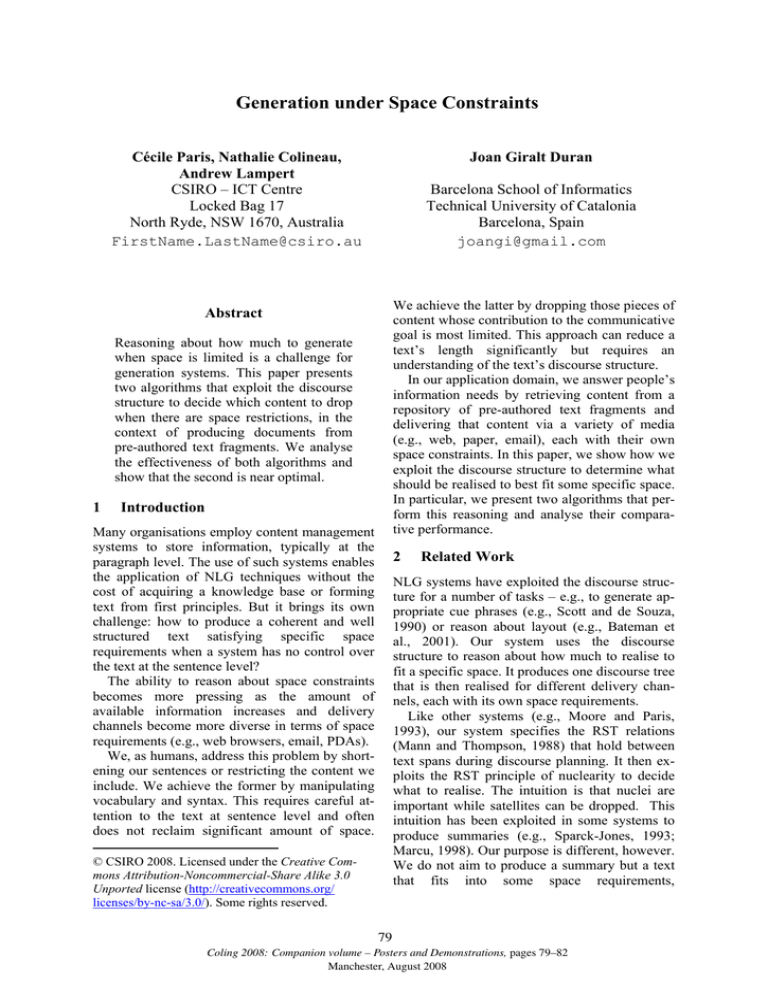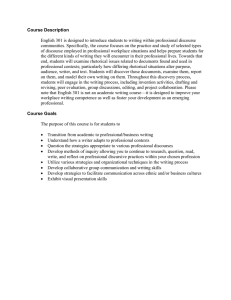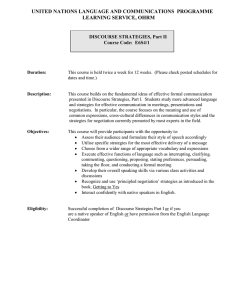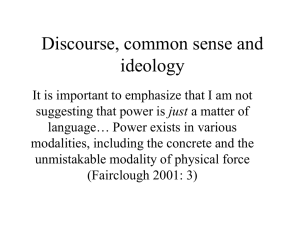
Generation under Space Constraints
Cécile Paris, Nathalie Colineau,
Andrew Lampert
CSIRO – ICT Centre
Locked Bag 17
North Ryde, NSW 1670, Australia
FirstName.LastName@csiro.au
Joan Giralt Duran
Barcelona School of Informatics
Technical University of Catalonia
Barcelona, Spain
joangi@gmail.com
We achieve the latter by dropping those pieces of
content whose contribution to the communicative
goal is most limited. This approach can reduce a
text’s length significantly but requires an
understanding of the text’s discourse structure.
In our application domain, we answer people’s
information needs by retrieving content from a
repository of pre-authored text fragments and
delivering that content via a variety of media
(e.g., web, paper, email), each with their own
space constraints. In this paper, we show how we
exploit the discourse structure to determine what
should be realised to best fit some specific space.
In particular, we present two algorithms that perform this reasoning and analyse their comparative performance.
Abstract
Reasoning about how much to generate
when space is limited is a challenge for
generation systems. This paper presents
two algorithms that exploit the discourse
structure to decide which content to drop
when there are space restrictions, in the
context of producing documents from
pre-authored text fragments. We analyse
the effectiveness of both algorithms and
show that the second is near optimal.
1
Introduction
Many organisations employ content management
systems to store information, typically at the
paragraph level. The use of such systems enables
the application of NLG techniques without the
cost of acquiring a knowledge base or forming
text from first principles. But it brings its own
challenge: how to produce a coherent and well
structured text satisfying specific space
requirements when a system has no control over
the text at the sentence level?
The ability to reason about space constraints
becomes more pressing as the amount of
available information increases and delivery
channels become more diverse in terms of space
requirements (e.g., web browsers, email, PDAs).
We, as humans, address this problem by shortening our sentences or restricting the content we
include. We achieve the former by manipulating
vocabulary and syntax. This requires careful attention to the text at sentence level and often
does not reclaim significant amount of space.
2
Related Work
NLG systems have exploited the discourse structure for a number of tasks – e.g., to generate appropriate cue phrases (e.g., Scott and de Souza,
1990) or reason about layout (e.g., Bateman et
al., 2001). Our system uses the discourse
structure to reason about how much to realise to
fit a specific space. It produces one discourse tree
that is then realised for different delivery channels, each with its own space requirements.
Like other systems (e.g., Moore and Paris,
1993), our system specifies the RST relations
(Mann and Thompson, 1988) that hold between
text spans during discourse planning. It then exploits the RST principle of nuclearity to decide
what to realise. The intuition is that nuclei are
important while satellites can be dropped. This
intuition has been exploited in some systems to
produce summaries (e.g., Sparck-Jones, 1993;
Marcu, 1998). Our purpose is different, however.
We do not aim to produce a summary but a text
that fits into some space requirements,
© CSIRO 2008. Licensed under the Creative Commons Attribution-Noncommercial-Share Alike 3.0
Unported license (http://creativecommons.org/
licenses/by-nc-sa/3.0/). Some rights reserved.
79
Coling 2008: Companion volume – Posters and Demonstrations, pages 79–82
Manchester, August 2008
Figure 1. A brochure generated by our system
the email body. All outputs are generated from
the same discourse structure by our algorithm.
Our need to deliver the brochure via multiple
channels led us to design algorithms that reason
about the content to be expressed and the space
available for each channel. The system follows a
two-stage approach: during discourse planning,
content and organisation are selected, and a discourse tree is built. The tree includes the top
level communicative goal, intermediate goals
and the rhetorical relations that exist between
text spans, encoding both the purpose of each
fragment and how they relate to each other. Then,
at the presentation stage, the system reasons
about this structure to decide what to realise
when there is too much content for some channel.
We implemented and tested two algorithms
for this reasoning. Both algorithms embody the
principle of nuclearity and exploit the notion that
some relations are more important than others.
An importance value is assigned to relations
based on their contribution to the communicative
goal. Table 1 shows our assignments, which are
based on judgments from our marketing staff.
To explain the algorithms, we represent the
discourse tree using an abstract view, as shown
in Figure 2. Each node is a communicative goal.
White nodes indicate nuclei. Satellites are shaded
in grey corresponding to the importance of the
rhetorical relation linking them to the nucleus.
The number inside each node is the approximate
amount of content that node produces (in lines).
potentially only slightly shortening a text. Our
task brings new challenges, e.g., filling the space
optimally and producing a balanced text.
Our system exploits the notion that some relations are more important than others. O’Donnell
(1997) used this principle to produce documents
of variable length. In his approach, sentence
fragments were manually marked up with RST
and the text was manipulated at or below the sentence level. In our work, we cannot manipulate
text at sentence level nor manually mark up the
documents to be shortened.
3
Reasoning about Space Constraints
We focus on applications in which the generated
text is delivered through several channels. One
such application is SciFly, which produces
tailored brochures about our organisation. Given
a query from a user (topic(s) of interest), the
system consults a staff directory and a repository
of text fragments to gather relevant information.
The fragments, written by our marketing team,
are self contained and comprised of one or two
paragraphs. SciFly integrates all the relevant
information into a coherent whole (see Figure 1)
using the meta-data describing each fragment’s
content. A text fragment can be used with different rhetorical relations in different brochures.
The system produces a 2-page paper brochure, a
web output, and a PDF version of the paper brochure is emailed to the user with a summary in
80
Shading
Black
Dark
Grey
Light
Grey
Discourse Relations
Illustration, Background,
Circumstance, Elaboration
Context, Motivation,
Evidence, Summary ,
Justification,
Preparation, Enablement
3.2 Enhanced Algorithm
Importance
Low
Low-Medium
Medium
We redesigned the algorithm to take into account
the depth of a node in addition to its rhetorical
status. We assign each node a weight, computed
by adding the weight of the node’s parent and the
penalty score of the rhetorical relation, which is
(inversely) related to its importance score. Penalty scores range from 1 to 6, in increments of 1:
A nucleus has a score of 1 to take the tree depth
into account, high importance relations have a
score of 2, and low importance relations have a
score of 6. In a discourse tree, a child node is
always heavier than its parent. The larger the
weight, the less important the node is to the
overall comunicative goal. The system orders the
nodes by their weight, and the heaviest nodes are
dropped first. Thus, nodes deeper in the tree and
linked by discourse relations with lower
importance get removed first. Nodes are dropped
one by one, until the top level node has an
amount of content that satisfies the space
constraint. This provides finer control over the
amount of realised content and avoids the
limitation of the first algorithm.
Medium-High
High
Table 1. Importance score for some relations 1
Each node is the root of a subtree (empty if the
node is a leaf) which generates some content. In
both algorithms, the system computes for each
node an approximation of the space required for
that content in number of lines (an approximation
as it depends on style, line-wrapping and other
formatting attributes in the final output). This is
computed bottom-up in an iterative manner by
looking at the retrieved content at each node.
Figure 2. Discourse tree with space annotations
3.1 Simple Algorithm
The first algorithm is simple. It checks whether
the top level node would result in too much
content given the space requirements of the
output channel (e.g., lines of content per page). If
yes, the system traverses the tree, selects satellites with the lowest importance value and drops
them with their sub-trees. The algorithm repeats
this process until the total amount of content fits
the required space. We deployed the SciFly
system with this algorithm at a trade fair in 2005
and 2006 and measured the experience visitors
had with the system. On average, people rated
the system positively but noted that there was
sometimes a lot of blank space in the brochures,
when they felt that more information could have
been included. This is because our simple
algorithm drops many sub-trees at once, thus
potentially deleting a lot of content in each step.
This led us to our enhanced algorithm.
Figure 3. Ordered list of (satellite) cluster nodes
Sometimes, a discourse structure contains
parallel sub-structures (e.g., bulletted points)
that, if pruned unevenly, result in unbalanced text
that seems odd. In such cases, the discourse
structure typically contains several sub-trees with
the same structure. In SciFly, such parallel
structures occur when describing a list of
projects. These are generated during discourse
planning by a plan containing a foreach
statement, e.g., (foreach project in project-list
(describe project)). To address this situation, the
system annotates all sub-structures issued from
such a foreach statement. When constructing the
ordered list of satellites, nodes at the same depth
in the sub-structures are clustered together, as
shown in Figure 3, taking into account their
relationship to the nucleus. When dropping
1
In our system, we consider 5 levels of importance. We
have merged levels here to avoid too many shades of grey.
81
nodes, the whole cluster is deleted toegether,
rather than node by node. So, in Figure 3, the
whole cluster of weight 10 is dropped first, then
the cluster of weight 8, etc. This prevents one
sub-structure from being pruned more than its
sibling structures and ensures the resulting
brochure is balanced.
4
for generation systems. Most systems either
control their generation process to avoid
producing large amounts of text at the onset, or
control the generation at the sentence level. In
our application, we cannot resort to any of these
approaches as we generate text reusing existing
text fragments and need to produce one discourse
tree with all the appropriate available content and
then select what to realise to output on several
delivery channels. To satisfy space constraints,
we implemented and tested two algorithms that
embody the notions of nuclearity and importance
of information to decide which content to keep
and which to withhold. Our approach produces
documents that fill most of the available space
while maintaining users’ satisfaction.
Evaluation
We evaluated the algorithms to assess their
comparative effectiveness, based on a test set of
1507 automatically generated brochures about
randomly selected topics. We observed that
82.5% of the brochures generated with the
enhanced algorithm filled over 96% of the
available space (leaving at most 8 lines of empty
space), compared to 29% of brochures generated
with the simple algorithm. In addition, 96.5% of
the brochures generated with the new algorithm
filled at least 90% of the space, compared with
44.5% of brochures with the simple algorithm.
We also found that 75% of brochures included
more content using the enhanced algorithm (an
average of 32 additional lines), but 12% of the
brochures contained less content. We examined
the latter in detail and found that, for these cases,
the difference was on average 4 lines, and that
the reduction was due to our treatment of parallel
discourse structures, thus representing a desirable
loss of content to create balanced brochures.
We also performed a user evaluation to verify
that the improvement in space usage had not decreased users’ satisfaction. We asked users to
compare pairs of brochures (simple algorithm vs.
enhanced algorithm), indicating their preference
if any. Seventeen users participated in the
evaluation and were presented with seven pairs
of brochures. To control any order effect, the
pairs were randomly presented from user to user,
and, in each pair, each brochure was randomly
assigned a left-right configuration. Participants
mostly preferred the brochures from the enhanced algorithm, or found the brochures equivalent, thus showing that our more effective use of
space had not decreased users’ satisfaction.
Overall, our results show that our enhanced
algorithm is close to optimal in terms of
conveying a message appropriately while filling
up the space and producing a coherent and
balanced text.
5
Acknowledgements
We thank M. Raji for her work on the user experiment, the members of our group and K.
Vander Linden for their input, and everyone who
participated in our evaluation.
References
John Bateman, T. Kamps, K. K. Reichenberger, K.
and J. Kleinz. 2001. Constructive text, diagram and
layout generation for information presentation: the
DArt_bio system. Computational Linguistics, 27
(3): 409–449.
William C. Mann and Sandra A. Thompson. 1988.
Rhetorical Structure Theory: Toward a functional
theory of text organisation. Text 8(3):243–281.
Daniel Marcu. 1998. To build text summaries of high
quality, nuclearity is not sufficient. In Working
Notes of the AAAI-98 Spring Symposium on Intelligent Text Summarization, Stanford, CA, 1–8.
Johanna D. Moore and Cécile L. Paris. 1993. Planning
Text for Advisory Dialogues: Capturing Intentional
and Rhetorical Information. Computational
Linguistics, 19 (4):651–694, Cambridge, MA.
Donia R. Scott and Clarisse S. de Souza. 1990.
Getting the message across in RST-based text
generation. In Dale, Mellish & Zock (eds). Current
Research in NLG. London: Academic Press. 119–
128.
Mick O’Donnell (1997). Variable Length On-Line
Document Generation. Proceedings of EWNLG.
Gerhard-Mercator University, Duisburg, Germany.
Karen Spark Jones (1993). What might be in a
summary? Information Retrieval 93: Von der
Modellierung zur Anwendung. (Ed: Knorz, Krause
and Womse-Hacker), Konstanz: Universitatsverlag
Konstanz, 9–26.
Conclusions
Reasoning about how much to generate when
space is limited presents an important challenge
82







